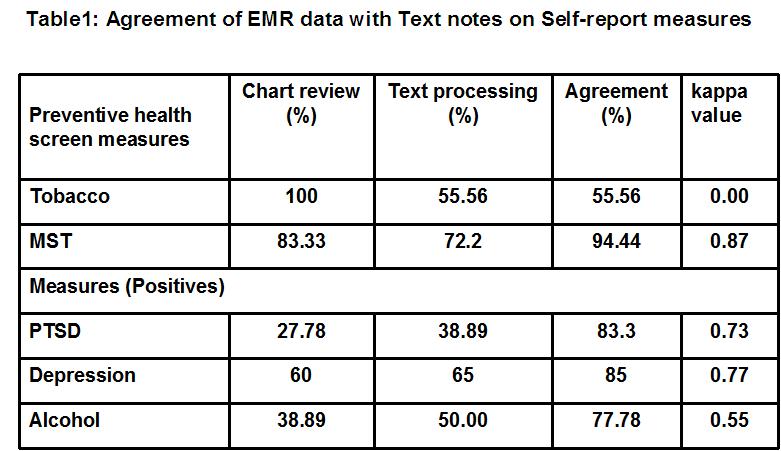|
||||
Tuesday, October 23, 2007
P3-44
USE OF ELECTRONIC MEDICAL RECORD DATA TO ASSESS HEALTH STATUS OF VETERANS RETURNING FROM IRAQ AND AFGHANISTAN
Purpose: The objective of the study is to discuss the feasibility and validity of using data electronically extracted from the Veterans Health Administration (VHA) electronic medical record (EMR - VistA) to assess health status from self-reported measures of alcohol, smoking, depression etc. of veterans returning from Iraq and Afghanistan (OEF/OIF). Methods: EMR data on OEF/OIF veterans with visits to the West-Haven, CT VA 2003- 2007 was extracted for this study into a SQL Server database. A full-text index was created on the progress notes where the clinical reminders are stored in the medical record (narrative text). Special database specific text searching queries such as forms of, and proximity were used. Analogous data was also electronically extracted from computable data fields in the EMR, and a random sample of charts were manually reviewed for validation purposes. Results: For the 1821 OEF/OIF veterans identified 1400 had at least one health care encounter at the West Haven, CT VA. 48.4% female veterans screened positive for depression vs. 38.6% male veterans (p=0.01). Among those screened for military sexual trauma 14.4% of females and 0.64 males screened positive (p<0.01). Females (11.7%) were less likely than males (29.8%) to have reported alcohol abuse (p<0.01). 33% males were diagnosed with PTSD as compared to 21% females (p<0.01). Twenty EMR records were randomly selected to validate the EMR data with text notes. Table 1 shows the agreement reported between chart review and text results. Conclusions: These results suggest that there is wide range of agreement between chart review and simple text processing depending on type of health measure assessed for OEF/OIF veterans. This limited query of EMR data demonstrates the importance of validating self reported data obtained from EMRs with targeted review of narrative-text notes to improve the quality of data electronically extracted from VistA.


